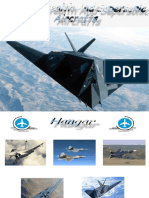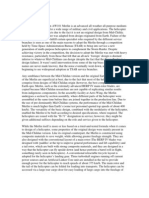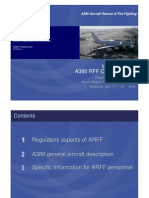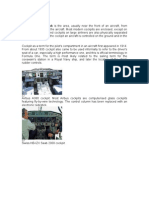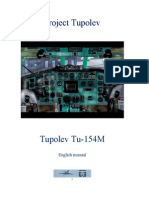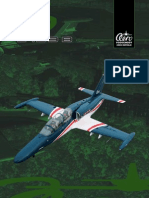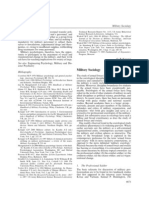CleosRealm AW139
CleosRealm AW139
Uploaded by
Fnaf YTCopyright:
Available Formats
CleosRealm AW139
CleosRealm AW139
Uploaded by
Fnaf YTOriginal Title
Copyright
Available Formats
Share this document
Did you find this document useful?
Is this content inappropriate?
Copyright:
Available Formats
CleosRealm AW139
CleosRealm AW139
Uploaded by
Fnaf YTCopyright:
Available Formats
For Training Use Only
AW139M Italian Multi-Role Helicopter
Tiers:
Domain: Air, Aircraft, Rotary Wing Aircraft, Medium Multi-role Helicopter
Proliferation: Algeria, Australia, Bangladesh, Brazil, Bulgaria, Chile, China, Croatia, Cyprus, Egypt, Estonia,
Indonesia, Ireland, Italy, Japan, Kenya, Lebanon, Libya, Malaysia, Malta, Nepal, Netherlands, Nigeria, Oman,
Pakistan, Panama, Qatar, Senegal, Spain, Sweden, Thailand, Trinidad and Tobago, Turkmenistan, United
Arab Emirates, United Kingdom of Great Britain and Northern Ireland, United States of America
Origin: Italy
Notes
The AW139 is a 15-seat medium-sized twin-engined helicopter developed and built by AgustaWestland, now
called Leonardo. It is marketed at several different roles, including military (AW139M), VIP/corporate transport,
offshore transport, fire fighting, law enforcement, search and rescue, emergency medical service, disaster
relief, and maritime patrol. In addition to AgustaWestland's manufacturing facilities in Italy and the United
States, the AW139 is produced in Russia by HeliVert, a joint venture between AgustaWestland and Russian
Helicopters.
The AW139 was originally designed and developed jointly by Agusta and Bell Helicopters and
marketed as the Agusta-Bell AB139, being redesignated AW139 when Bell withdrew from the project. Since
entering service in 2003, the AW139 has become one of AgustaWestland's most influential products; it has
been subsequently developed into two enlarged medium-lift helicopters, the military-orientated AW149 and the
AW189 for the civil market.
The AW139 is a conventional twin-engine multi-role helicopter. It has a five-bladed
fully articulated main rotor with a titanium hub and composite blades and a four-bladed articulated tail rotor. It
1 Exported (UTC) @ 4/3/23, 4:55 PM
For Training Use Only
is fitted with retractable tricycle landing gear, the two aft wheels retracting into external sponsons which are
also used to house emergency equipment. It is flown by a crew of two pilots, with up to 15 passengers
accommodated in three rows of five. The AW139 had been aimed at a vacant niche in the market, sitting
below larger types such as the Eurocopter AS332 Super Puma and Sikorsky S-92, and above smaller ones
like the Bell 412 and Eurocopter EC155. "Rotor & Wing" has described the AW139's flying attitude as 'docile
and predictable'.
The AW139 is powered by two FADEC-controlled Pratt & Whitney Canada PT6C turboshaft
engines; the FADEC system seamlessly adjusts the engines for pilot convenience and passenger comfort, and
can automatically handle a single-engine failure without noticeable deviation. It was constructed with
maintenance requirements in mind; critical systems can be readily accessed, where possible the number of
parts has been reduced, and many components have been designed for an extended lifecycle; a Health and
Usage Monitoring System (HUMS) is also equipped. More than a thousand customizable items of equipment
can be configured per customer demand, including auxiliary fuel tanks, rescue hoists, cargo hooks, search
and weather radar, ice protection systems, external cameras and searchlights, and seating arrangements.
The
AW139 features a modular glass cockpit, a commonly-installed feature being the four-axis autopilot, which
enables functions such as auto-hover capability. The cockpit has been designed to enable single-pilot flight
operations under instrument flight rules conditions, and it is also compatible with the use of night vision
goggles. Pilot training for the type is available via advanced Level D Full Flight Simulators. According to
"Shipping & Marine", the AW139 has "the largest cabin in its class"; containing up to 15 passengers or four
litters and accompanying medics, an additional baggage compartment is used to stow equipment to keep the
main cabin clear for use.
Large sections of the AW139 have been developed and produced by a range of
different companies. Airframes are typically produced by PZL-Świdnik, who delivered their 200th airframe in
April 2014. Pratt & Whitney Canada produce the type's PT6C turboshaft engines, while the primary and
secondary transmissions were developed by Westland GKN and Kawasaki Heavy Industries respectively. A
significant portion of the avionics are sourced from Honeywell. Turkish Aerospace Industries has been
subcontracted to manufacture various elements of the AW139, including the fuselage, canopy, and radome.
Final assembly of most AW139s is performed at AgustaWestland's facilities in Philadelphia, United States, and
Vergiate, Italy; those destined for customers within the Commonwealth of Independent States are typically
assembled by a third final manufacturing plant in Tomilino, Moscow operated by HeliVert.
Variants
AB139: Original Italian-built production aircraft, 54 built.
2 Exported (UTC) @ 4/3/23, 4:55 PM
For Training Use Only
AW139M: Militarized variant, capable of carrying various weapons payloads.
HH-139A: Italian Air Force designation for ten search-and rescue configured AW139Ms.
VH-139A: Italian Air Force designation for two VIP configured AW139s.
US139: Military variant, was the AgustaWestland proposed entry for the US Army Light Utility Helicopter
programm in partnership with L-3 Communications.
MH-139 Grey Wolf: This is a militarized variant selected by the U.S. Air Force. It can carry nine fully equipped
troops; has a top cruise speed of 135 knots and can fly at least three hours, and a minimum distance of 225
nm, without needing refueling.
The helicopter is equipped with an electro-optical/infrared sensor turret under
the nose and provisions for machine gun mounts on either side. For some operations, it may be fitted with
hoists for search-and rescue or other mission-specific gear.
AW139 (long nose configuration): Long nose variant with increased room for avionics built in Italy and the
United States.
System
Primary Function: Utility Helicopter
Crew: 2
Blades, Main Rotor: 5
Blades, Tail Rotor: 4
Number of Engines: 2
Day/Night Capable: Yes
All Weather Capable: Yes
Vertical Climb Rate: INA
Number of Hard Points: INA
3 Exported (UTC) @ 4/3/23, 4:55 PM
For Training Use Only
Cockpit Options: A Honeywell Primus Epic core avionics system comes in either the basic visual flight rules
(VFR), instrument flight rules (IFR) three-axis automatic flight control system (AFCS), IFR four-axis digital
AFCS or SAR versions
Passengers: 15, less if fully equipped, not to exceed 2,500kgs
Litters: ILO passengers, 6 liters with 4 medical personnel
FLIR: Yes
Dimensions
Length, Overall: 16.6
Length, Fuselage: 13.5
Width, Across Cabin: 2.3
Width, Across Sponsons: 3.2
Height: 4.9
Weight, Max Takeoff: 6,000
Main Rotor Diameter: 13.8
Load, Useful: 2,500
Load, External: 2,700
Cabin, Interior Volume: 8
Automotive
Engine Name: Pratt and Whitney Canada PT6C-67C
Engine Type: Turboshafts with FADEC (full-authority digital engine control)
Engine Power: Maximum continuous power of 1,531hp (1,142 kW)
4 Exported (UTC) @ 4/3/23, 4:55 PM
For Training Use Only
Cruising Range: 750km, 3 hours and 54 minutes without reserves
Speed, Maximum: 309
Speed, Average: 290
Armament
Note: The AW139M can be armed with Internal and external weapons such as general purpose machine
guns, sniper rifles, heavy machine gun pods and 70mm rocket pods, forward firing rockets and machine guns,
pintle mounted machine gun and Air-to-Surface Missile (ASM) system.
The firing of weapons is controlled by a
weapon management system equipped with head up display.
Protection
Note: The low thermal and acoustic signature improves the survivability of the AW139M helicopter. The
cockpit and cabin can be equipped with ballistic protection. The crew protection is further improved with
armored seats. The helicopter also includes ballistic-tolerant, self-sealing fuel tanks.
The onboard missile
approach warning system provides threat information to the pilot for actuating the helicopter’s
countermeasures. The Counter Measures Dispensing System (CMDS) deceives incoming missiles.
Cockpit Glass: Yes
Stealth Properties: No
Heat Signature Reduction: Yes
Add on Armor: No
NBC Protection: INA
EW: INA
EW Counter Measures/CCM: INA
Counter Measures (Chaff/Flares): Yes
IR: Low acoustic and infrared (IR) emissions
5 Exported (UTC) @ 4/3/23, 4:55 PM
You might also like
- Aw139 Ems - 0Document5 pagesAw139 Ems - 0jags86100% (2)
- Body AW189 OffshoreDocument5 pagesBody AW189 OffshorePeter Ijaramendi100% (3)
- Airplane Designing..... Zero ApproximationDocument33 pagesAirplane Designing..... Zero ApproximationMelvin Philip100% (3)
- CN 235 AircraftDocument11 pagesCN 235 AircraftKrisna Kiira Morino67% (3)
- Body Copia Di Brochure Aw139mDocument5 pagesBody Copia Di Brochure Aw139mDHRUV100% (2)
- Brochure AW139 SARDocument8 pagesBrochure AW139 SARJuan Carlos Letona100% (1)
- AW139Document14 pagesAW139Amy KlezanNo ratings yet
- Project ADocument39 pagesProject AGhanithan SubramaniamNo ratings yet
- Ec 135 PDFDocument24 pagesEc 135 PDFORLANDO CASTILLONo ratings yet
- Brochure AW189 Offshore PDFDocument4 pagesBrochure AW189 Offshore PDFGiuseppeTrotta100% (1)
- AgustaWestland AW109 HelicopterDocument15 pagesAgustaWestland AW109 HelicopterAmy Klezan100% (1)
- Airbus A330 MRTTDocument15 pagesAirbus A330 MRTTDave GoSky100% (4)
- A 330Document210 pagesA 330perry.stamatiouNo ratings yet
- A380 Pilots GuideDocument26 pagesA380 Pilots GuideJoseph Michael Leal100% (1)
- ATR 72 - WikipediaDocument4 pagesATR 72 - Wikipediata_ac117100% (1)
- C130.investigators Handbook - Chapter1 PDFDocument9 pagesC130.investigators Handbook - Chapter1 PDFUsNdaomanuNo ratings yet
- Indian Air Force (IAF) IL 78MKI Mid Air Refuelling Tanker AircraftDocument10 pagesIndian Air Force (IAF) IL 78MKI Mid Air Refuelling Tanker AircraftLuptongaNo ratings yet
- K.S Institute of Technology: Internship PresentationDocument25 pagesK.S Institute of Technology: Internship PresentationDeviprasad MNo ratings yet
- European Military AircraftDocument204 pagesEuropean Military Aircraftjb2ookworm100% (2)
- AW139MDocument2 pagesAW139MManuel MoralesNo ratings yet
- AW101 MerlinDocument11 pagesAW101 Merlinkct86100% (2)
- HondaJet SpecificationsDocument5 pagesHondaJet SpecificationsJohn Jennings100% (1)
- Untitled DocumentDocument11 pagesUntitled DocumentyadaomargaretteNo ratings yet
- Embraer ERJ Family Aircraft Manual PDFDocument56 pagesEmbraer ERJ Family Aircraft Manual PDFStephen OHaraNo ratings yet
- Single Seat Ultralight Sailplane For Selfbuilders: Eel - Entwicklung Und Erprobung Von LeichtflugzeugenDocument5 pagesSingle Seat Ultralight Sailplane For Selfbuilders: Eel - Entwicklung Und Erprobung Von Leichtflugzeugenedavies99950% (4)
- Grob Aircraft Was Originally A German Aircraft Factory Founded in 1926 by Ernst Grob in Munich. in The Beginning, Production Was Limited ToDocument16 pagesGrob Aircraft Was Originally A German Aircraft Factory Founded in 1926 by Ernst Grob in Munich. in The Beginning, Production Was Limited Todawud MohammedNo ratings yet
- SUAS CompetitionDocument13 pagesSUAS CompetitionShikhar MoondraNo ratings yet
- Introduction To A380 ARFFDocument48 pagesIntroduction To A380 ARFFszilvascribdNo ratings yet
- Question Bank: 2 Mark Question and AnswersDocument11 pagesQuestion Bank: 2 Mark Question and Answersraj6062No ratings yet
- A109 NavalDocument2 pagesA109 NavalLavern P. SipinNo ratings yet
- Aircraft Shelter. FAC: 1466: Table 1.1Document3 pagesAircraft Shelter. FAC: 1466: Table 1.1dzolyNo ratings yet
- CockpitDocument6 pagesCockpitNadeem AnsariNo ratings yet
- Aero L-159A Czech Jet Combat AircraftDocument16 pagesAero L-159A Czech Jet Combat AircraftSilentistics100% (1)
- Zlin Aircraft Airplanes enDocument9 pagesZlin Aircraft Airplanes enrechovaNo ratings yet
- As332 Tech Data l1Document57 pagesAs332 Tech Data l1Lee Jihoon100% (3)
- Avro RJ General Data Brochure PDFDocument66 pagesAvro RJ General Data Brochure PDFMonica Enin100% (2)
- Bell 412EP DataBrochureDocument6 pagesBell 412EP DataBrochureNash7777No ratings yet
- Tu 154M111Document262 pagesTu 154M111arknaNo ratings yet
- Aircraft 6Document2 pagesAircraft 6panNo ratings yet
- Leonardo-Finmeccanica AW189 Full Ice Protection System Certification Clears Way For All-Weather OperationsDocument2 pagesLeonardo-Finmeccanica AW189 Full Ice Protection System Certification Clears Way For All-Weather OperationsFaizahKadirNo ratings yet
- A109LUH Brochure PDFDocument2 pagesA109LUH Brochure PDFLavern P. SipinNo ratings yet
- Aero L-159B Czech Jet Trainer AircraftDocument16 pagesAero L-159B Czech Jet Trainer AircraftSilentistics100% (2)
- Aerofly Professional Deluxe Addon 3 (True Scale Addon) : Description of The SceneriesDocument6 pagesAerofly Professional Deluxe Addon 3 (True Scale Addon) : Description of The ScenerieswisamakramNo ratings yet
- Avro BAe 146Document60 pagesAvro BAe 146Plutarca BenavidesNo ratings yet
- AutopilotDocument23 pagesAutopilotHimanshuTripathiNo ratings yet
- A380 Briefing For Pilots Part 2 1Document303 pagesA380 Briefing For Pilots Part 2 1norstar101100% (1)
- ULF-1 e NeuDocument5 pagesULF-1 e NeuShalon MeloNo ratings yet
- Air Crash Investigations - Cracked Solder Joint - The Crash of Indonesia Air Asia Flight 8501From EverandAir Crash Investigations - Cracked Solder Joint - The Crash of Indonesia Air Asia Flight 8501No ratings yet
- Air Crash Investigations - Crew in Disarray, The Crash of Sibir Airlines Flight C7 778From EverandAir Crash Investigations - Crew in Disarray, The Crash of Sibir Airlines Flight C7 778No ratings yet
- MRAPs - Main Resistant Ambush Protected VehiclesFrom EverandMRAPs - Main Resistant Ambush Protected VehiclesRating: 5 out of 5 stars5/5 (1)
- Unmanned Combat Aerial Vehicle: Revolutionizing Warfare through Autonomous Air PowerFrom EverandUnmanned Combat Aerial Vehicle: Revolutionizing Warfare through Autonomous Air PowerNo ratings yet
- British Aerospace Hawk: Armed Light Attack and Multi-Combat Fighter TrainerFrom EverandBritish Aerospace Hawk: Armed Light Attack and Multi-Combat Fighter TrainerNo ratings yet
- Plane Crashes: The 10 Deadliest Air Disasters And the Lessons We Learned to Improve Aviation SafetyFrom EverandPlane Crashes: The 10 Deadliest Air Disasters And the Lessons We Learned to Improve Aviation SafetyNo ratings yet
- Helicopter Flying Handbook (2025): FAA-H-8083-21BFrom EverandHelicopter Flying Handbook (2025): FAA-H-8083-21BRating: 4.5 out of 5 stars4.5/5 (3)
- Pilot's Encyclopedia of Aeronautical Knowledge: Federal Aviation AdministrationFrom EverandPilot's Encyclopedia of Aeronautical Knowledge: Federal Aviation AdministrationRating: 4 out of 5 stars4/5 (18)
- A330 Normal Law: Putting Fly-by-Wire Into PerspectiveFrom EverandA330 Normal Law: Putting Fly-by-Wire Into PerspectiveRating: 5 out of 5 stars5/5 (2)
- CleosRealm Leo1A3Document9 pagesCleosRealm Leo1A3Fnaf YTNo ratings yet
- CleosRealm BO 105Document7 pagesCleosRealm BO 105Fnaf YTNo ratings yet
- Nsiad 91 5Document24 pagesNsiad 91 5Fnaf YTNo ratings yet
- Gau 8Document1 pageGau 8Fnaf YTNo ratings yet
- A3 Development of Dictatorship Germany 1918-1945Document12 pagesA3 Development of Dictatorship Germany 1918-1945fadum099100% (1)
- General Antonio Luna BackgroundDocument5 pagesGeneral Antonio Luna BackgroundPauline August FernandezNo ratings yet
- Iwi - Israel Weapon Industries LTD.: The X95 - One Rifle - Three Calibers Suitable For All Combat ScenariosDocument12 pagesIwi - Israel Weapon Industries LTD.: The X95 - One Rifle - Three Calibers Suitable For All Combat ScenariosMasalu ThomasNo ratings yet
- 4 Basic MarkmanshipDocument8 pages4 Basic MarkmanshipOLSNo ratings yet
- Army - FM3 52X3 - JATC - MULTI-SERVICE PROCEDURES FOR JOINT AIR TRAFFIC CONTROLDocument156 pagesArmy - FM3 52X3 - JATC - MULTI-SERVICE PROCEDURES FOR JOINT AIR TRAFFIC CONTROLMeowmix100% (1)
- SSC GD Constable (2024) Official Paper (Held On - 29 Feb, 2024 Shift 4)Document25 pagesSSC GD Constable (2024) Official Paper (Held On - 29 Feb, 2024 Shift 4)rakhi.bhashkerNo ratings yet
- Fiche Robin 1Document7 pagesFiche Robin 1api-3716076No ratings yet
- Developing Warrior Mindset and Mentality - Basic Tactical Thinking and PrinciplesDocument121 pagesDeveloping Warrior Mindset and Mentality - Basic Tactical Thinking and PrinciplesAnonymous XDGO5BH79CNo ratings yet
- United States of AmericaDocument39 pagesUnited States of AmericaThian HongNo ratings yet
- Rotor Tales - 07 - 01 - Final1Document24 pagesRotor Tales - 07 - 01 - Final1William RiosNo ratings yet
- How To Win in A DogfightDocument27 pagesHow To Win in A DogfightIvan Randja RandjelovicNo ratings yet
- H.R.1808 - Assault Weapons Ban of 2021Document126 pagesH.R.1808 - Assault Weapons Ban of 2021AmmoLand Shooting Sports NewsNo ratings yet
- Electrical Experimenter 05 GernDocument68 pagesElectrical Experimenter 05 Gernpozman100% (1)
- Noida Group Housing Data PDFDocument254 pagesNoida Group Housing Data PDFYogesh BaggaNo ratings yet
- Asoac Edition 119 BlakerDocument16 pagesAsoac Edition 119 Blakeremiliopolo1No ratings yet
- Military SociologyDocument4 pagesMilitary SociologyJacobin Parcelle100% (2)
- BSG Faq 1 1 3Document6 pagesBSG Faq 1 1 3fleabag8194No ratings yet
- Appointments: May 2019 AllDocument46 pagesAppointments: May 2019 AllGyms DanielNo ratings yet
- Joint Publication 1-02 Dept. of Defense Dictionary of Military and Associated Terms (Thru Sept. 2013) Uploaded by Richard J. CampbellDocument493 pagesJoint Publication 1-02 Dept. of Defense Dictionary of Military and Associated Terms (Thru Sept. 2013) Uploaded by Richard J. CampbellRichard J. Campbell https://twitter.com/No ratings yet
- 8-TAMIL GR ResearchDocument9 pages8-TAMIL GR ResearchsheikhalaatifNo ratings yet
- Tavor Sar & Tavor X95: Operator Manual RevisionDocument8 pagesTavor Sar & Tavor X95: Operator Manual RevisionN'fast NgNo ratings yet
- TXTDocument128 pagesTXTAndy WilsonNo ratings yet
- CPR - HippocratesDocument3 pagesCPR - HippocratesJerelyn Rose PalayNo ratings yet
- The Gettysburg Address Assignment Visionary Discourse by AsadDocument5 pagesThe Gettysburg Address Assignment Visionary Discourse by AsadAsad Mehmood100% (2)
- Browning Machine Gun Cal 50 M2 Water Coo PDFDocument286 pagesBrowning Machine Gun Cal 50 M2 Water Coo PDFWin Zaw AungNo ratings yet
- Dust1947 Cards Square SSU v3 ENG 22-08-17Document101 pagesDust1947 Cards Square SSU v3 ENG 22-08-17nevio31No ratings yet
- ĐỀ TIẾNG ANH LỚP 8Document3 pagesĐỀ TIẾNG ANH LỚP 8Lan HoàngNo ratings yet
- Ukraine's Hidden Advantage 2023 05-11-09 59Document10 pagesUkraine's Hidden Advantage 2023 05-11-09 59Sabrina CASTIGLIONI MORELLONo ratings yet
- All About History - Henry VIII Issue 130 2023 - All About HistoryDocument84 pagesAll About History - Henry VIII Issue 130 2023 - All About Historyszilagyi.marta74100% (2)
- The Morning Calm Korea Weekly - Mar. 24, 2006Document24 pagesThe Morning Calm Korea Weekly - Mar. 24, 2006Morning Calm Weekly NewspaperNo ratings yet







